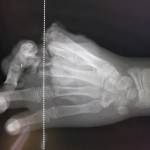Twelve-year-old Muna Z. was playing outside her home when a half buried object caught her eye. Always inquisitive, she started to dig up the item to discover what it was. As Muna Z. leaned over to pull the object from the ground, her would-be treasure detonated.
Muna Z.’s father rushed outside when he heard the commotion and saw that the unexploded ordnance (UXO) (i.e., unexploded mine, rocket, mortar, bullet) that triggered his daughter’s curiosity had cost her an eye and part of her right hand.
“Muna Z.’s father sought medical help in the local area, but was turned away. He brought her to our combat support hospital praying that we could do whatever was possible to prevent complete amputation of her hand. We quickly determined she had sustained a traumatic blast amputation of her right index finger, near amputation of her middle finger, and associated fractures of the second and first metacarpal bases. It was apparent that her eye had sustained an open globe injury and could not be salvaged. He cried as he explained his biggest fear was that her hand would be amputated and what that stigma would mean for her future life in the community. Realizing this stigma, as well as the functional activities of daily living (ADL) challenges Muna Z. will now face in her life will be much more difficult with only one hand, we did our best to perform a salvage. While we operated, her father prayed outside on our porch.”
Question:
In this setting, to what lengths should we proceed in order to obtain subspecialty care for this individual? Often the mantra in austere environments is that measures to save “life, limb, or eyesight” qualify patients to receive priority care that may include aeromedical evacuation.




